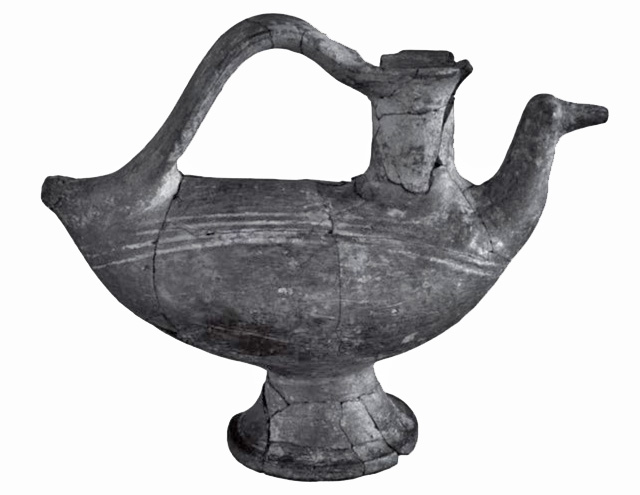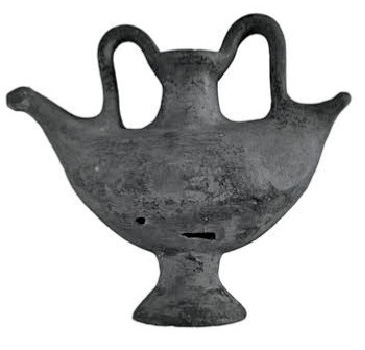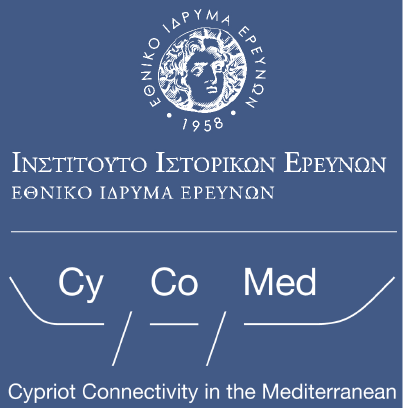Cyprus and the LBA/EIA metallurgy on Thasos
Dr Petya Ilieva Bulgarian Academy of Sciences

The Northern Aegean is rarely considered in discussions of the LBA – EIA patterns of interaction between the Aegean and the Eastern Mediterranean and if so, it is usually mentioned in the context of the Phoenician pursuit of metals. The still very limited amount of objects of Cypriot and Levantine origin or associations and their patchy distribution in the Northern Aegean record restricts the feasibility of a systematic approach and renders any conclusion preliminary. Considering the strong ties between Cyprus and metropolitan Phoenicia, including the establishment of Kition on the island, the contemporary advance and sometimes shared context of Cypriot and Phoenician artefacts in the Northern Aegean, as well as the nature of the expanding Late Geometric and Archaic sea-borne commercial networks linking the Aegean and the Eastern Mediterranean, it seems very likely that some (if not most) Levantine materials reached the Northern Aegean via or from Cyprus itself. Cypriot and Phoenician finds from the area attest to increased overseas contacts, usually interpreted in light of the Euboean activities in the Northwestern corner of the Aegean. Nevertheless, the archaeological record indicates that Euboean merchants and settlers did not venture east of Chalkidice peninsula, while written testimonies and scattered finds suggest that the role played by Cypriots and Phoenicians in the central and eastern part of the Northern Aegean is still underestimated.
Hdt. 6.47 famously discusses a Phoenician establishment led by the eponymous Thasos on the homonymous island predating that of the Parian settlers. According to the narrative, these Phoenicians began the exploitation of the mines in the mountain between Koinyra and Ainyra, in the eastern part of the island, facing Samothrace. Ancient mining galleries were discovered in the location suggested by Herodotus, but no evidence for exploitation earlier than the end of 6th – early 5th c. BC has come to light. The place-names Ainyra and Koinyra have repeatedly been recognised as Phoenician and connected to Semitic roots for silver and gold, thus enhancing the impression in favour of Phoenician mining activities on the island. However, a possible link with the name of the autochtonous Cypriot king Kinyras has also been suggested. A link between Cyprus and LBA/EIA metallurgy on Thasos, although still poorly manifested in terms of material evidence, seems more promising rather than direct connection with the Levantine coast. This does not reject the possibility that Phoenicians were involved in sailing and trading far north, but they may have benefitted from the knowledge on the area that the Cypriots already had.
Four burial grounds at Kastri and Larnaki on Thasos, spanning chronologically between the late LBA and the 8th c. BC, have yielded a number of bronze and bimetal knives. The majority of bronze knives discovered in LBA graves belong to Aegean types. Results from lead-isotope analysis indicate that although a local copper was used for some of these, most of the knives were made of imported copper which falls within or close to the Cypriot field. Bimetallic knives, dating to the final years of the LBA or the transition to the EIA, were also part of the burial equipment of the Kastri and Larnaki graves. They mark the earliest appearance of iron on the island and the chemical composition of their bronze handles indicates a most likely origin of the copper within the Cypriot field. This fact may indicate that the beginning of the metallurgy of iron on Thasos might have been stimulated by external factors such as imports from Cyprus. The Cypriot link can also be indirectly illustrated by the compositional analysis of a glass-bead from Kentria cemetery on Thasos, which matches the composition of the glass from the 11th – 10th c. BC site of Frattesina in northern Italy. The site appears to have had commercial links with Cyprus which could account for the appearance of the glass-bead on Thasos. Two more Late Bronze Age bronze knives from Thasos, one which might have originated from the Laurion copper deposits and another one made of pure copper with composition consistent to that of Ergani Maden in Anatolia, as well as the Frattesina type glass bead, could be seen as an additional indication that the northern Aegean was part of the 12th and early 11th c. BC long-distance Cypriot maritime networks connecting the eastern and central Mediterranean, the Aegean and Anatolia. Whether the Cypriot involvement was a direct one, considering the fact that Cyprus retained its active commercial position after the collapse of the Mycenaean palace centres, or it was organised via Aegean ports of trade, requires further evidence.


The late 8th – 7th c. BC archaeological evidence from the Northern Aegean
There seems to be a clear gap between the 12th /early 11th c. BC contacts of the local community on Thasos with Cyprus/the Aegean and the renewal of the contacts with the Aegean neighbours in the second half of the 8th c. BC, when the island becomes part of a locally developed, Northern Aegean exchange network. The early Cypriot and Phoenician commercial ventures, illustrated by the earliest finds at Lefkandi in the late 11th c. BC and by the gradually increasing archaeological evidence from the 10th and 9th century BC Euboea and the southern Aegean (Dodecanese, Crete), were not echoed in its northern part. A still modest number of late 8th – 7th c. BC artefacts of Phoenician and Cypriot origin or association provide a basis for discussion and reconsideration.
Karabournaki, identified with ancient Therme, is a Northern Aegean port where Phoenician, as well as Cypriot, ceramics were discovered. These include fragments belonging to the distinctive pottery class familiar by the descriptive term Black-on-Red (BoR). Macroscopically identificatied as Cypriot imports, the Karabournaki fragments were stratigraphically related to a plethora of late 8th/ first half of the 7th c. BC ceramics. A Cypriot decorated pottery fragment from the site was recently added.Torone, to the east, is the only site in the Northern Aegean where mouth and neck fragments of two small perfume vessels (juglets) have been identified so far. The fabric, the dark-red slip and the morphology of first one suggest a Phoenician manufacture, although an origin in Cyprus or even the Dodecanese is possible. The dark red fabric with dark grey, polished slip and traces of burnishing of the second fragment allow for its attribution to Cypriot Grey Polished Ware. Both juglet fragments come from unrelated and unstratified contexts, while comparanda from Cyprus and the Levant suggest that a date in the first half of the 7th c. BC seems plausible.
An isolated basket-handle transport amphora dated to the second half of the 7th c. BC was discovered in the early Klazomenian cemetery of Abdera. This type of container originates in Cyprus and represents a comparatively rare find in the early Archaic Aegean. The Cypriot amphorae discovered in the Aegean come from sites with strong Levantine associations such as Kommos and Rhodes, and Miletus is also the source of ca. 20 fragments of basket-amphorae. A rare, non-ceramic evidence for Cypriot trade activities was discovered in the coastal cemetery of Mende on Chalkidice. A late 8th/ early 7th c. BC Attic SOS amphora with a short inscription incised on its shoulder in Cypriot syllabary was used as a burial container. It contains part of a personal name. The vessel also bears three incised vertical lines on the handle, a practice popular on Cyprus for marking the capacity of the containers. The Mende inscription finds an almost identical, early 7th c. BC parallel in one from Policoro, South Italy, which makes a possible common Cypriot background for the two containers not unlikely. The date of the Mende inscription fits well into the late 8th – first half of 7th c. BC horizon of Cypriot and Phoenician finds in the Northern Aegean littoral.Unlike the Thermaic Gulf and the Chalkidice peninsula, the north-eastern corner of the Aegean still lacks direct evidence that Cypriot and Phoenician goods reached its coastal sites, despite the testimonies in the Iliad (6.289, 23.740-745). Nevertheless, a limited in number vases of Cypriot and Phoenician inspiration rendered in local fabric provide an interesting case of ceramic emulation, indirectly suggesting a good level of aquaintance with earlier and contemporaneous Cypriot and Phoenician shapes. The late 8th – 7th c. BC cemetery on the island of Tenedos is the source of bird askoi manufactured in the tradition of the North-West Anatolian Gray Ware: 1: a stemmed askos with bird’s head and a spout on the back (fig. 1); 2: a stemmed double askos with a spout on top of the back flanked by two handles, and two bird’s tails, one at each end, instead of a head (fig. 2); 3: two askoi with a ring-shaped body, a trefoil spout reminiscent of a beak, a triangular tail opposite it and a handle connecting spout and tail (fig. 3). While the introduction of the bird askos in the EIA Aegean ceramic repertory (Euboea, Crete, Dodecanese) is associated with Cyprus, its local manufacture in the Dodecanese is attested down to the Late Geometric period. It is very likely, therefore, that the local, Gray Ware bird askoi from Tenedos were influenced by contemporaneous examples from places such as Rhodes and Cos, rather than Cyprus itself. A ring-vase from the same burial ground as well as a Gray Ware Phoenician type trefoil mouthed jug from Troy (fig. 4) enhance the impression that the local inhabitants were familiar with vases of Cypriot and Phoenician inspiration, but not necessarily origin. Considering that Euboean commercial and colonising activities were confined to the Northwestern Aegean it seems that the knowledge of Cypriot and Phoenician shapes may have reached the northeastern Aegean following an eastern route, from the Dodecanese via Ionia. A limited number of LG/EA imported wares (bird kotylai and bird bowls) found in Troy, Madytos and Tenedos suggests that during these periods the Northeastern Aegean was in contact with Ionian centres.
Discussion
The northern Aegean archaeological record indicates that, apart from the late 12th/ early 11th c. BC bronze and bimetal knives from Thasos suggesting a possible Cypriot link, it is not before the late 8th c. BC, when artefacts of Cypriot and Phoenician origin or associations reached the Northern Aegean. A well-defined horizon of late 8th – 7th c. BC date finds material expression in a variety of imported artefacts, concentrated in sites around the Thermaic Gulf and Chalkidice. On the other side, contemporaneous, locally made Gray Ware vases from Tenedos and Troy to the east present a case of an emulation of characteristic Cypriot and Phoenician pottery shapes, while no imports have come to light so far.
Whether the Eastern Mediterranean goods reached the Northern Aegean on board of Phoenician, Cypriot or Greek ships would be rather speculative to argue. A plethora of various trade partners may have contributed to a dynamic network of exchange which is far from being ethnically clear-cut and accounts for the blend of Cypriot, Phoenician and Phoenician-type artefacts in the Northern Aegean.

The spread of such finds around the Thermaic Gulf and Chalkidice could be seen in the light of the Euboean activities and interests in the area. It may have been part of a northern branch of Aegean commercial networks connecting the Eastern Mediterranean via Euboea and Skyros to the Thermaic Gulf. A possible eastern route between Cyprus and the Levantine coast, the Dodecanese and Ionia may have contributed to the acquaintance of the potters of the Northeastern Aegean with diagnostic Cypriot and Phoenician ceramic shapes. The limited volume and diverse nature of finds of Εastern Mediterranean origin or inspiration in the Νorthern Aegean suggest that their distribution in the area could be the end result of the activity of intersecting regional exchange networks with ports of trade facilitating mixed merchandise cargoes. Cyprus, with its mixed demographic background, maritime expertise, long-lasting commercial experience and favourable location, provides a natural intersecting point for the Levantine and Southern Aegean trade routes. It is not a surprise, therefore, that Cypriot vases and a Phoenician jug of probably Dodecanese origin were discovered in Karabournaki, that a Cypriot and a Phoenician neck-ridge juglets came from Torone, or an Attic SOS amphora with Cypriot syllabary inscription from Mende. This complex, mixed nature of the Late Geometric and early Archaic exchange system could be also illustrated by the slightly later Cypriot basket amphora from Abdera which is indicative for the role of the Southeastern Aegean and Ionian ports of trade in distributing eastern Mediterranean goods. A link between the Northern Aegean and East Greece as early as the late 8th c. BC can be illustrated by ceramic wares originating in a number of Northern Aegean sites.
The archaeological record from the area suggests that a direct link with metropolitan Phoenicia is currently hard to prove. This does not mean, however, that Phoenician people (merchants, craftsmen) did not reach the Northern Aegean. It seems that the process has happened via places such as Cyprus, Euboea, or Rhodes where Phoenicians had already settled (Kition, Rhodes) or their presence is advocated (Euboea). The opening of the Northern Aegean (mainly its western corner) for the Aegean commerce facilitated the appearance of Cypriot, Phoenician and Phoenician-style objects in the area. It probably involved eastern Mediterranean people, Cypriots and Phoenicians who were already present in the Aegean, active in crafts and commercial exchange and extending their activities to the North, likely in cooperation with Greeks (especially Euboeans). There is an obvious difference in the volume and nature of the relevant material and written record from and for the western and the eastern parts of the Northern Aegean. If we accept Homer and Herodotus’s claims for Phoenician presence in the Northeastern Aegean, the lack of archaeological expression should perhaps be linked to the pattern of interaction with the native non-Greek people. Integration of a small number of easterners among the local communities is not unlikely. The instrumental role of the Euboeans as middlemen between the Eastern Mediterranean and the Southern Aegean on one side and its Northwestern part (the Thermaic Gulf and the western tips of Chalkidice) on the other, has been repeatedly advocated, they did not venture much beyond that towards the central and eastern part of the Northern Aegean which was still a non-Greek territory in the late 8th and the very beginning of the 7th c. BC. The lack of material expression of the postulated Phoenician involvement along the coast to the east of river Strymon is perhaps not a mere coincidence. It can be compared to the lack of Mycenaean and Geometric finds in the same area and may point at the strong presence (political and economic) of the local Thracian tribes. It does not necessarily mean, however, that there was no interaction between the local Thracians and Cypriots or Phoenicians from Cyprus reaching the Northern Aegean, whose mobility and presence in the area should not be underestimated.Bibliography
Blonde, F., A. Muller, D. Mulliez, M. Kohl and G. Sanidas. 2008. “Thasos in the age of Archilochos.” In Archilochos and his Age. Paros 2, Proceedings of the 2nd International Conference on Paros and the Archaeology of the Cyclades, Paros, October 2005, edited by D. Katsanopoulou, I. Petropoulos and S. Katsarou, 67-83. Athens: Diktynna.
Fletcher, R. 2008. “Fragments of Levantine Iron Age pottery in Chalkidike.” Mediterranean Archaeology 21:3-7.
Graham, A.J. 1987. “The foundation of Thasos.” Annual of the British School at Athens 73:61-98.
Graham, A.J. 1992. “Abdera and Teos.” Journal of Hellenic Studies 112:44-73.
Ilieva, P. 2019. “Phoenicians, Cypriots, Euboeans in the Northern Aegean: a reappraisal.” AURA 2:65-102.
Καρναβά, A. 2013. “Κύπριοι της 1ης χιλιετίας στον ελλαδικό χώρο: η μαρτυρία των συλλαβικών επιγραφών.” In Epigraphy, Numismatics, Prosopography and History of Ancient Cyprus. Papers in Honour of Ino Nicolaou, edited by D. Michaelides, 159–169. Uppsala: Åströms förlag.
Κασσέρη, Ε. 2012. “Φοινικική εμπορικοί αμφορείς από τη Μεθώνη Πιερίας.” In Κεραμέως παίδες. Αντίδωρο στον Καθηγητή Μηχάλη Τιβέριο από τους μαθητές του, edited by Ε. Κεφαλίδου and Δ. Τσιαφάκη, 299-308. Θεσσαλονίκη: ΕΑΕ.
Μπουρογίαννης, Γ. 2007. Κυπριακή και φοινικική κεραμική στο Αιγαίο κατά τους πρώιμους ιστορικούς χρόνους: εμπορικά δίκτυα και το πρόβλημα του Black-on-Red, PhD diss, University of Athens.
Sherratt, S. 2010. “Greeks and Phoenicians: Perceptions of Trade and Traders in the Early First Millennium BC.” In Social Archaeologies of Trade and Exchange: Exploring Relationships between People, Places, and Things, edited by A. Agbe-Davies and A. Bauer, 119-42. Walnut Creek: Left Coast.
Sherrat, S. 2019. “Phoenicians in the Aegean and the Aegean Silver, 11th – 9th c. BC.” In Les Pheniciens, les Puniques et les autres, edited by L. Bonadies, I. Chirpanlieva and E. Gouillon, 129-158. Paris: Editions de Boccard.
Τιβέριος, Μ. 2004. “Οι πανεπιστημιακές ανασκαφές στο Καραμπουρνάκι Θεσσαλονίκης και η παρουσία των Φοινίκων στο Βόρειο Αιγαίο.” In Το Αιγαίο στην Πρώιμη Εποχή του Σιδήρου, edited by Ν. Σταμπολίδης and Α. Γιαννικούρη, 295-303. Αθήνα: ΤΑΠΑ.
Tiverios, M. 2012. “The Phoenician presence in the Northern Aegean.” In Greeks and Phoenicians at the Mediterranean Crossroads, edited by P. Adam-Veleni and E. Stefani, 65-73. Archaeological Museum of Thessaloniki Publications no.15. Thessaloniki: Ziti.
Vainstub, D. 2014. “A Phoenician votive inscription on a figurine from Stageira and the root ṬN.'” In Phéniciens d'Orient et d'Occident: mélanges Josette Elayi, edited by A. Lemaire, 345-350. Paris: Editions Jean Maisonneuvre.
Vokotopoulou, I., A. Christidis. 1995. “A Cypriot Graffito on an SOS Amphora from Mende, Chalcidice.” Kadmos 34:5-12.
